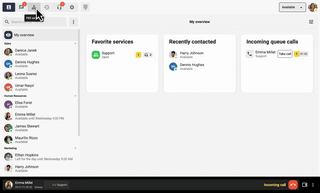The link between security, verification and customer experience.
Customer experience and safety
It should come as no surprise that your company’s customer experience is the key to success. 91% of customers surveyed are likely to return after a positive experience. Customer experience is affected by every single interaction with your business. This includes, for example, visits to your website, what they buy and – as this guide discusses – the dialog they have with your support.
This is probably the most important thing of all, as customer service and customer experience go hand in hand. Usually, customers only contact your support if they have a problem, so giving them a positive experience can be the key to keeping them.
Customers’ expectations of service are higher than ever. This, combined with growing concerns about our digital security, means that support staff face a difficult task. How do you provide good and understanding customer support, while maintaining high security standards?

Read more: How to update your company’s security in 10 minutes
It is of utmost importance for organizations to know who they are talking to. Companies need to watch out for external threats such as contact center scammers, which are people who call customer support pretending to be someone else in order to gain access to payment details and other sensitive information. Businesses need to combat this to protect both their own systems and their customers’ data. Otherwise, the consequences can be devastating.
Cumbersome security requirements impair the customer experience
One challenge with this is that support systems often have problems with authentication. Requiring customers to remember long passwords and other data becomes a speed bump. It does not make for a good customer experience. In fact, in the long run, such problems can affect customer needs and company revenue.
Having to go through a lengthy verification process before even speaking to an agent frustrates many. It not only reduces the time it takes to resolve the case, but requires more from the customer when they are likely already stressed. Avoiding such stressful moments during the process can reduce customer frustration. This, in turn, increases the likelihood that they will find the dialog fruitful.
Customers still have high expectations
However, the solution to this is not as simple as removing all requirements and tools you have for verification. Customers expect the services they use to have secure systems. Failing to do so and not protecting their privacy and data can harm your business. Making it too ‘easy’ for customers to access information is dangerous – as is making it too ‘difficult’ – especially if it involves sensitive information such as bank details or medical records.
Simple verification that the customer recognizes

Many businesses are increasingly looking to digital tools for verification to maintain both security and the customer experience. Allowing customers to confirm their identity with a reliable and easy-to-use tool reduces the disruption of a lengthy verification process, while ensuring that both you and the customer feel that security is a priority.
There are a variety of tools for this, so it is important to choose the right one. In Sweden, however, there is one choice that is almost obvious to everyone: BankID. Companies operating in Sweden cannot afford not to use BankID, given how common it is.
The advantage of BankID is that it is an easy-to-use and widely recognized solution. This helps customers to trust the platform that uses it. Whatever tool you choose, it needs to be intuitive and user-friendly, while inspiring trust.
How you use digital verification depends on the system you choose. Telavox has an integration with BankID that can be used in two ways: it can be used as part of the switchboard, which means that the customer needs to verify themselves before reaching an agent. Or the verification can be done during a call.
Either way, it’s quick and the customer understands why they are being asked to verify. A simple and logical process means the customer has a positive experience.
Read more: 4 simple steps to successful business telephony
Digital security empowers your customers
Customers increasingly demand to do things on their own. They want to be able to make changes themselves in a user-friendly way, instead of having to interact with support staff. This affects security in two ways:
- Your customers want to feel that the platform they are using is secure.
With a secure platform, customers feel that they can, for example, adjust settings and add information on their own, as they trust it. They should not feel that it is too “easy” to access sensitive information. For example, it should not be possible to access payment information without logging in. - Your customers expect the security requirements to be commensurate with what they want to do.
You may allow your customers to view information or create something new without having to go through complicated security processes. However, you may require verification to, for example, edit or delete files or access sensitive information.
By reviewing how you implement your security in a tactical way, you ensure that it enhances rather than disrupts the customer experience. The goal is to have a sufficient standard so that the customer feels that you are taking care of their data, without taking up their valuable time.
Balancing verification and privacy
One thing to keep in mind when planning your security process is how to balance privacy with the need for verification. This is especially important when it comes to telephone support. It’s not always that the customer wants to share sensitive data with an agent.
When planning your security, ask yourself the question “How much information does the agent need to do their job?”. You could have a tier-based system where only managers can access sensitive information. Alternatively, you can use the above method with, for example, BankID to confirm the customer’s identity, without them having to share it with an agent.
Regardless, it is always good to be transparent with the customer about how much data the agent has access to.
The importance of human interaction
Digital security is extremely valuable and can transform the customer experience, but it’s important not to overlook the importance of the human aspect. Sure, customers may prefer to make changes without external help, but that only makes the interactions they have with your support even more important. If your customers get in touch, it probably means they have a problem they can’t solve themselves. In that case, it’s up to your support team to give them a positive response.
Digital security is no substitute for common sense. You may have to disregard your processes to solve a problem in the right (but safe) way. For example, it is important to have a plan B in case your system stops working. If for some reason your verification tool does not work, it is important that you can still identify customers safely and easily.
Alternatively, it may be that someone who is not a contact at the company has a legitimate reason to access particular data, for example if that person is a family member of an account owner who has passed away. A responsible support team should have processes in place to deal with such cases.
Don’t underestimate the importance of high-quality customer service. It’s essential that your agents have the tools to do so. Automation and chatbots are useful, but skilled, empathetic and knowledgeable agents are what sets your business apart from all others.
By staying on top of trends and changes in customer service and offering customized solutions for different customers, you can use the most valuable resource you have – your staff – as efficiently as possible.
Executive summary
Customers expect security but don’t want it to be a barrier. Balancing ease of access with data protection is a challenge, but you can do it with careful planning.
Using digital verification tools is a way to avoid complicated processes and give your customers a positive experience. A combination of digital solutions and skilled agents is the most effective way to give your customers a safe and satisfying experience when they get in touch.

